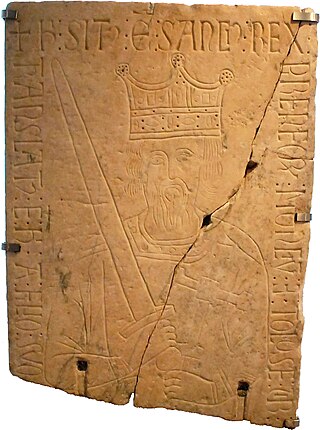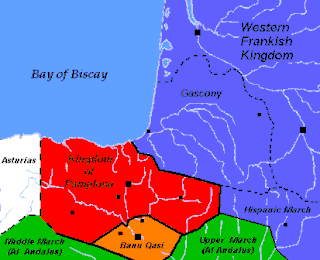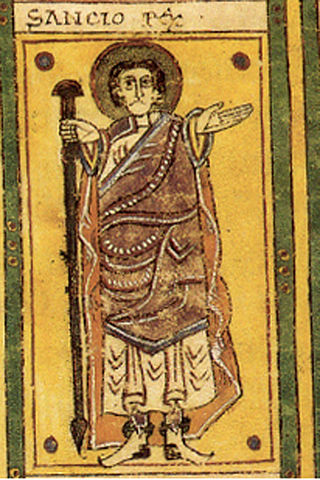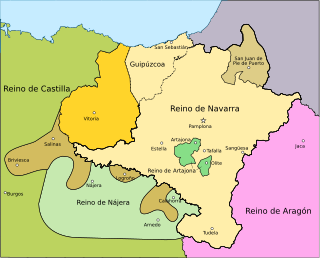| Ruler | Born | Reign | Death | Ruling part | Consort | Notes |
|---|
| García Jiménez |  | c.835 | c.850-885 | After 885 | Pamplona | Oneca of Sangüesa
two children
Dadildis of Pallars
two children | Sub- or co-king in a part of Pamplona, during the rule of Garcia I Iñiguez and/or Fortún Garcés of Pamplona. |
| Sancho I Abarca |  | c.860 | 905-925 | 10 December 925 | Pamplona | Toda Aznárez of Larraun
six children | Supplanted Fortun Garcés as king of Pamplona |
Jimeno Garcés of Pamplona
| | c.860 | 925-932/3 | 932/3 | Pamplona | Sancha Aznárez of Larraun
three children | Brother of Sancho I. He appears as prince or king, first acting alone, then along with his nephew, Garcia. |
| Toda Aznárez of Larraun (regent) |  | 2 January 876 | 925-933 | 15 October 958 | Pamplona | Sancho I of Pamplona
six children | Regent in name of her son. |
| Garcia Sánchez I | 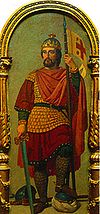 | 919 | 933-970 | 22 February 970 | Pamplona | Andregoto Galíndez of Aragon
c.935
(annulled 943)
two children
Teresa of León
c.943
three children | Minor son of Sancho I at the time of his father's death, he first appears a few years later as co-king with his uncle Jimena, then sole king under the regency of his mother. At his death the Kingdom of Viguera was created for his younger son. |
| Sancho II |  | 938 | 943-970 | 994 | Aragon | Urraca Fernández of Castile
962
four children | Son of Garcia Sánchez I and Andregoto. |
| 970-994 | Pamplona & Aragon |
| Ramiro Garcés |  | c.945 | 970-981 | 9 July 981 | Viguera | Unknown
two sons | Son of Garcia Sánchez I and Teresa of León. First king of Viguera. |
| Sancho Ramírez | | ? | 981-1002 | c.1002 | Viguera | Unknown
a daughter? | Left no male descendants and was succeeded by his brother. Possibly regent, or even king, of Pamplona 1000-1002 |
| Garcia Sánchez II the Trembling |  | 964 | 994-1000 | (29 July?) 1000 | Pamplona
(994-1000) | Jimena Fernández of Cea
c.988
four children | |
| Urraca Fernández of Castile (regent) |  | ? | 994-997 | 1007 | Aragon | Urraca Fernández of Castile
962
four children | Daughter of Fernán González of Castile and Sancha Sánchez of Pamplona. Previously wife of Ordoño III of León and Ordoño IV of León. |
| |
| Gonzalo Sánchez | | ? | 994-997 | 997 | Aragon | Unmarried | Son of Sancho II. Ruled under regency of his mother, probably died still a minor. |
| In 997 Aragon was reabsorbed in Pamplona |
| Garcia Ramírez | | ? | 1002-1025 | c.1025? | Viguera | Toda
two children | After his death with no male descendants, Viguera was reabsorbed in Pamplona. |
| In 997 Viguera was reabsorbed in Pamplona |
| Jimena Fernández of Cea (regent) | | c.970 | 1000-1014 | c.1045 | Pamplona & Aragon | Garcia Sánchez II
c.988
four children | Regent in name of her son, with her mother-in-law. |
| Sancho III the Great |  | c.992 | 1014-1035
(1034) | 18 October 1035 | Pamplona | Muniadona of Castile
c.1011
five children | His death precipitated a division of the historical Pamplona lands, a distribution that evolved into three Iberian kingdoms: Aragon, Navarre and Castile. |
| Ferdinand I the Great | 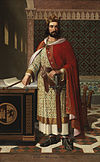 | 1016 | 1029-1037
1037-1065
(1056) | 27 December 1065 | Castile
Castile & León | Sancha, Queen of León
1032
five children | Younger son of Sancho III, he was named count of Castile by his father following the death of his maternal uncle in 1029. He merged this into the Kingdom of León, which he acquired in right of his wife Sancha in 1037. At his death he divided his kingdom into three for his sons, while naming his daughters suzereign over cities. |
| Garcia Sánchez III of Nájera |  | 1012 | 1035-1054 | 1 September 1054 | Pamplona | Stephanie of Foix
1038
Barcelona
eight children | Eldest legitimate son of Sancho III, received Pamplona and suzereignty over his brothers. |
| Gonzalo Sánchez | | 1020 | 1035-1045 | 26 June 1045 | Sobrarbe & Ribagorza | Unmarried | Son of Sancho III, received the counties of Sobrarbe and Ribagorza, which came from his mother, who had rights over those territories. Left no descendants, and his territories went to his half-brother Ramiro. |
| Sobrabe and Ribagorza were absorbed by Aragon |
| Ramiro I | 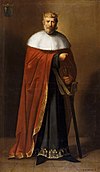 | 1006/7 | 1035-1063 | 8 May 1063 | Aragon | Ermesinda of Foix
c.1035
five children
Agnes of Aquitaine I
after 1049
no children | Natural son of Sancho III, received lands in Aragon that he eventually expanded into a sub-kingdom through the absorption of his brother Gonzalo's counties. |
| Sancho IV the Noble | 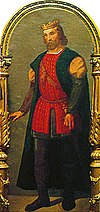 | 1039 | 1054-1076 | 4 June 1076 | Pamplona | Plaisance of Normandy
c.1068
three children | Assassinated. He left a minor child, Garcia Sanchez, but he was considered not fit for the throne for his age, and the throne was given to the king of Aragon. |
| Sancho Ramírez (V of Pamplona) | 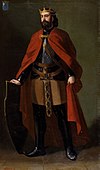 | 1042 | 1063-1076
1076-1094 | 4 June 1094 | Aragon
Pamplona & Aragon | Isabella of Urgell
1065
(annulled 1070)
one child
Felicia of Roucy
1076
three children | Son of Ramiro I, was chosen as the new king of Pamplona in 1076, reuniting the kingdoms once more. |
| Sancho II the Strong |  | 1038/9 | 1065-1071
1071-1072 | 7 October 1072 | Castile
Castile & León | Alberta
no children | Son of Ferdinand I, from 1071 deposed his brothers and took briefly control of all the inheritance of his father, before he was assassinated. |
| Castile was reabsorbed in León |
| Garcia II | 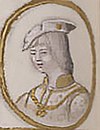 | 1042 | 1065-1071 | 21 March 1090 | Galicia | Unmarried | Son of Ferdinand I, from 1071 he was deposed by Sancho II and Alfonso; tried to return after Sancho's assassination, but Alfonso arrested and banished him to the Castle of Luna, where he eventually died many years later. |
| Galicia was reabsorbed in Castile, and then in León |
| Alfonso VI the Brave |  | 1040 | 1065-1071
1072-1109
(1077) | 21 March 1090 | León
León & Castile | Agnes of Aquitaine
1073/4
no children
Constance of Burgundy
1079
one child
Bertha (of Savoy?)
25 November 1093
no children
Isabel (Zaida?)
c.1100
two (three?) children
Beatrice
1108
no children | Reunited the inheritance of his father and conquered Kingdom of Toledo, but his only surviving children were daughters. The kingdom went to eldest daughter Urraca, while the County of Portugal, given to his daughter Theresa and her husband, would become the Kingdom of Portugal a generation later. |
| Peter I |  | 1068 | 1094-1104 | 28 December 1104 | Aragon & Pamplona | Agnes of Aquitaine
1086
Jaca
two children
Bertha (of Savoy II?)
1097
no children | Son of Sancho Ramírez. His own children didn't survive him and he was succeeded by his brother Alfonso. |
| Theresa |  | 1080 | 1096-1128 | 11 November 1130 | Portugal | Henry of Burgundy
1096
six children | Daughter of Alfonso VI, co-ruled in Portugal with her husband since 1096. Her ambition of reuniting the county with the old Kingdom of Galicia, with her adoption of royal title from 1116, and alliances with important Galician families led the Portuguese nobles to support her son Afonso Henriques as a candidate for the comital throne. Deposed after her defeat at Battle of São Mamede in 1128. |
| With the death of Teresa the line of the Jimena family died out in Portugal, which was inherited by Afonso Henriques, from the Portuguese House of Burgundy . |
| Alfonso I the Battler |  | 1073 | 1104-1134
(1109) | 7 September 1134 | Aragon & Pamplona | Urraca I of León and Castile
1109
(annulled 1112)
no children | Died without children. Left his kingsdoms to the knightly orders, the nobility of the two kingdoms chose different scions of the Jimenez dynasty as their kings, separating the two kingdoms. |
| Urraca the Reckless | 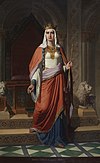 | April 1079 | 1109-1111
1109-1126
(1109) | 8 March 1126 | Galicia
León & Castile | Raymond of Burgundy
c.1087
two children
Alfonso I of Aragon
1109
(annulled 1112)
no children | Daughter of Alfonso VI, abdicated from Galicia to her son in 1111. Her problematic marriage with Alfonso of Aragon brought many conflicts between the spouses, even after their separation in 1112. Those conflicts endured throughout her reign. |
| With the death of Urraca the line of the Jimenez family died out in León & Castile, which were inherited by Alfonso VII of León and Castile, from the House of Ivrea . |
| Garcia V (Ramírez) the Restorer | 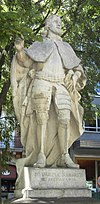 | ? | 1134-1150 | 21 November 1150 | Pamplona | Margaret of L'Aigle
1130
four children
Urraca of Castile the Asturian
24 June 1144
León
no children | Grandson of Sancho Garcés, illegitimate son of Garcia Sánchez III of Pamplona. |
| Ramiro II the Monk |  | 24 April 1086 | 1134-1137 | 16 August 1157 | Aragon | Agnes of Aquitaine
13 November 1135
Jaca
(annulled 1136/7)
one child | Last surviving son of Sancho Ramirez. Withdrawn from monastic life to inherit the throne, then as soon as his daughter was old enough to marry, he wed her to the Count of Barcelona, to whom he passed royal authority. |
| Sancho VI the Wise |  | 1133 | 1150-1194 | 27 June 1194 | Navarre | Sancha of Castile
2 June 1157
Carrión de los Condes
six children | He was the first monarch to adopt the title King of Navarre. |
| Petronilla I |  | 29 June/11 August 1136 | 1137-1164 | 15 October 1173 | Aragon | Ramon Berenguer IV, Count of Barcelona
August 1150
Lleida
five children | Petronila I of Aragon, only daughter of Ramiro II, got married with Ramon Berenguer IV, ruler of the count of Barcelona. The dynastic union in 1137 gave rise to the Crown of Aragon. Through the prenuptial agreement (Capitulaciones matrimoniales) under Aragonese law, Petronila I was the sole queen, while Ramon Berenguer IV only becoming consort princeps but not king nor proprietor of the Kingdom of Aragon. After his death, Petronila abdicated in 1164 to their son, Alfonso II of Aragon who continued the dynasty of House of Aragon and also inheritating the title of count of Barcelona following his father's House of Barcelona. After the abdication, she pursued a monastic life for herself. [7] |
| Sancho VII the Strong |  | 17 April 1154 | 1194-1234 | 7 April 1234 | Navarre | Constance of Toulouse
1195
(annulled 1200)
no children | Left no descendants. The Navarrese throne went to his French nephew, the count of Champagne. |
| With the death of Sancho VII the line of the Jimenez family died out in Navarre, which were inherited by Theobald I of Navarre, from the House of Champagne. As Sancho VII was the last living member of the family at the time of his death, Jimena dynasty became extinct after his death. |





























